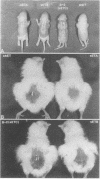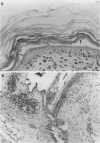Abstract
A new type of staphylococcal exfoliative toxin (sET) was isolated from the culture filtrate of a Staphylococcus aureus strain isolated from a horse with skin infection including phlegmon. The new sET was purified by precipitation with 80% saturated ammonium sulfate, column chromatography on DEAE-cellulofine A-500, gel filtration on a Sephadex G-75 column, and polyacrylamide gel electrophoresis (7.5% polyacrylamide). The new sET elicited general exfoliation of the epidermis with the so-called Nikolsky sign when inoculated into both 3-day-old mice and 1-day-old chicks, whereas sETA and sETB from human strains of S. aureus caused exfoliation in a 3-day-old mouse alone and shET from a porcine strain of Staphylococcus hyicus caused exfoliation in 1-day-old chicks alone. Intraepidermal splitting was observed at the granular layer of the epidermis of mice inoculated with the new sET as well as those inoculated with sETA. Exfoliation at the germinative layer of the epidermis was also observed in the chicks inoculated with the new sET as well as those inoculated with shET. The new sET was serologically different from sETA, sETB, and shET and showed the same molecular weight on sodium dodecyl sulfate-polyacrylamide gel electrophoresis. It was thermolabile and lost its toxicity after being heated at 60 degrees C for 15 min. We propose that the new sET be designated as sETC.
Full text
PDF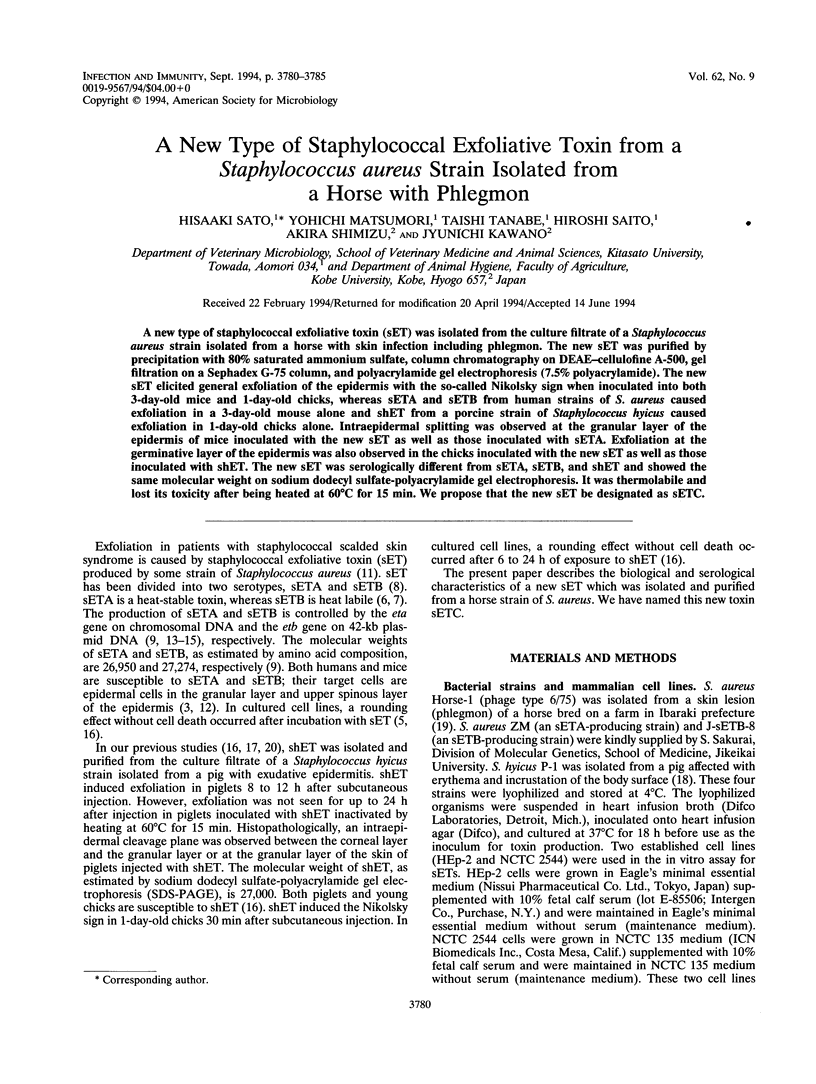
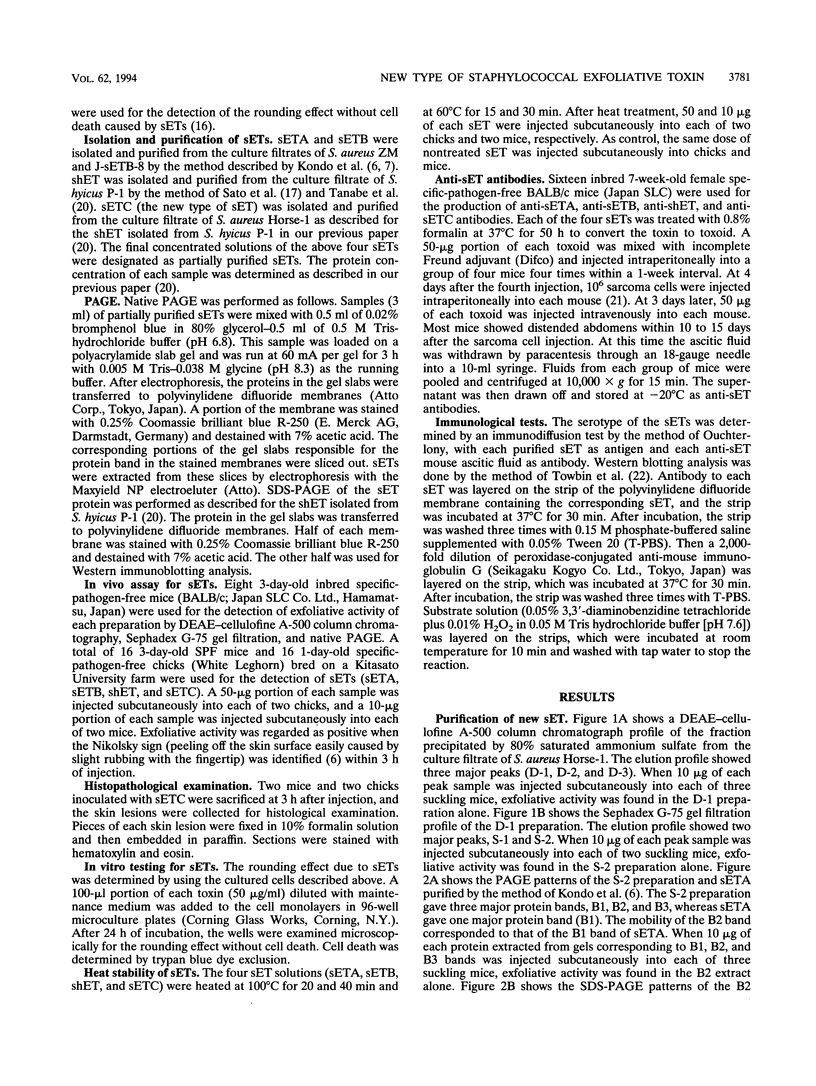
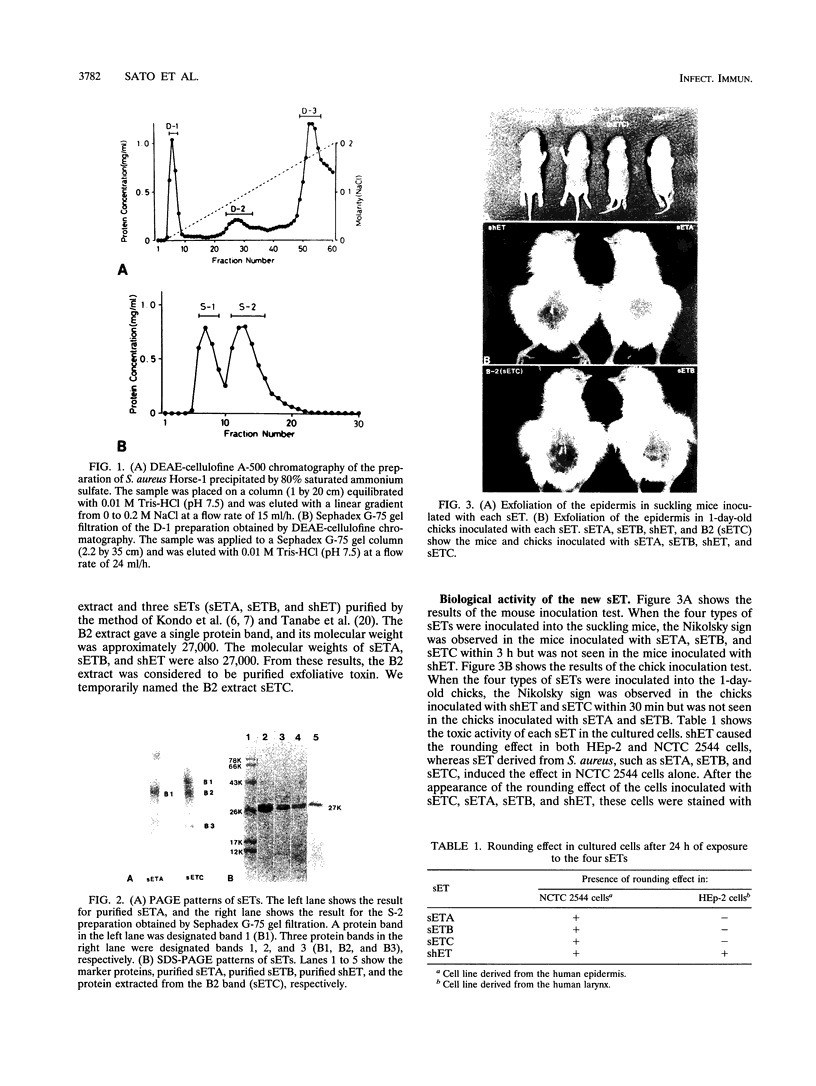
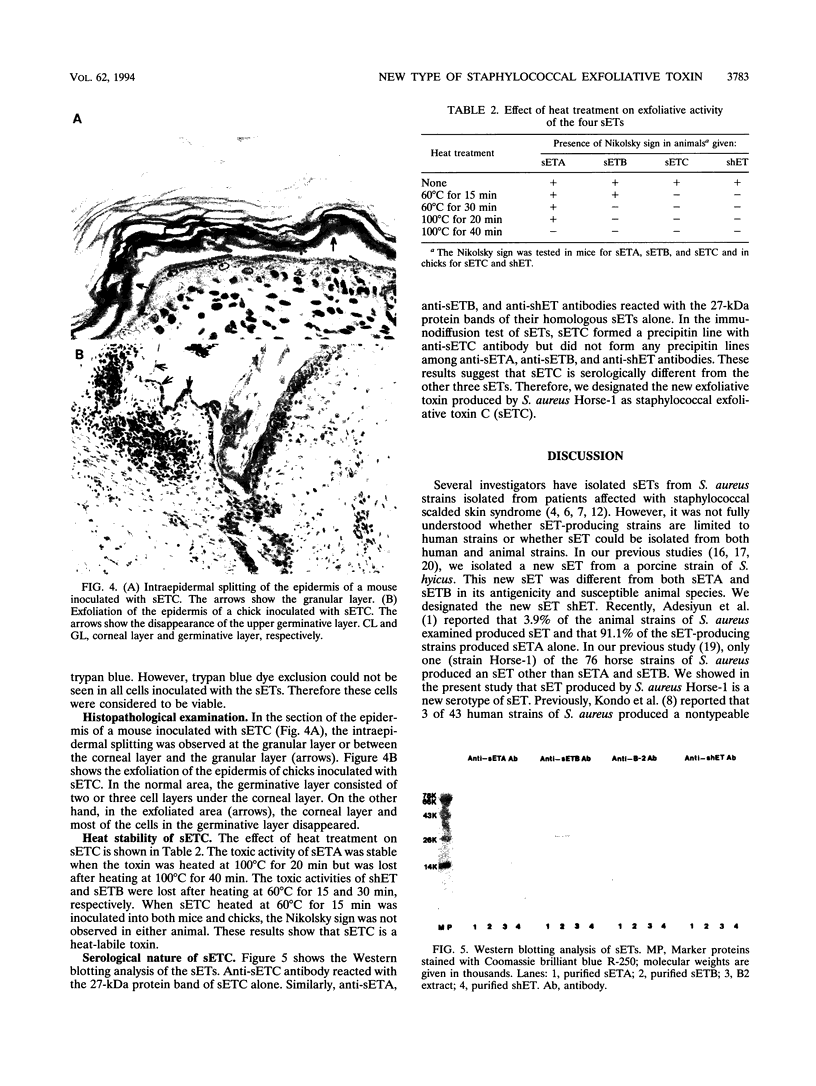
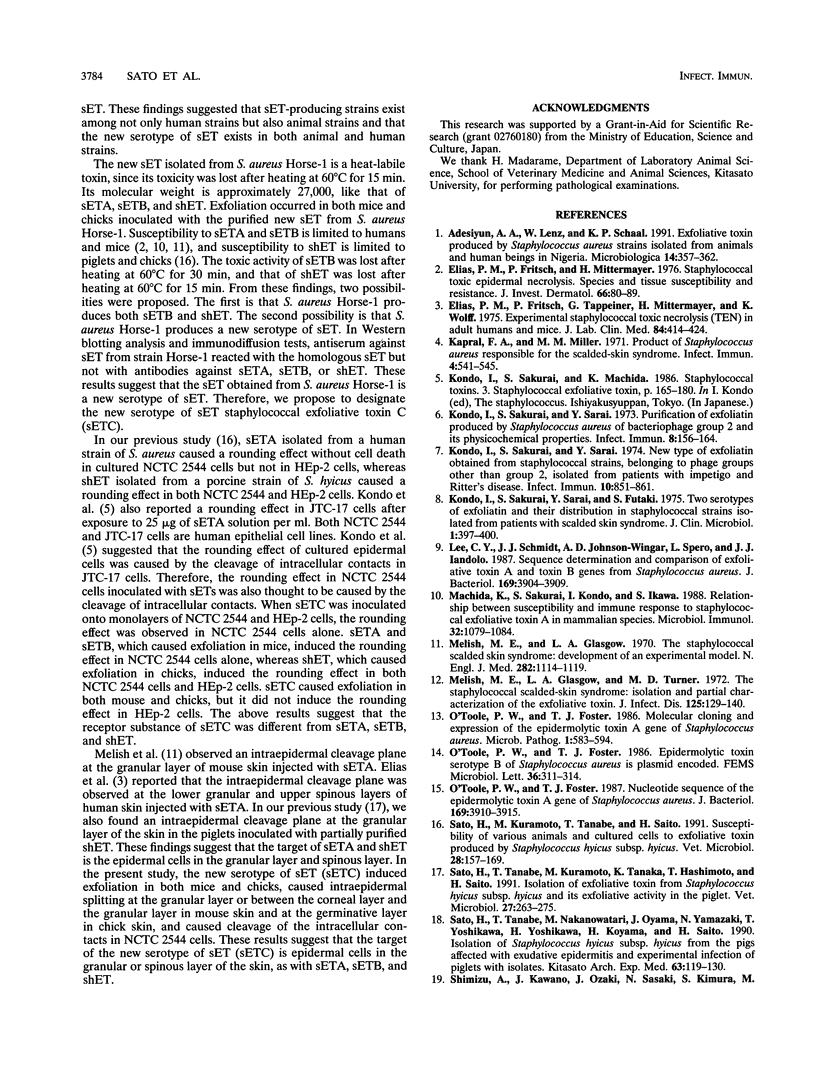

Images in this article
Selected References
These references are in PubMed. This may not be the complete list of references from this article.
- Adesiyun A. A., Lenz W., Schaal K. P. Exfoliative toxin production by Staphylococcus aureus strains isolated from animals and human beings in Nigeria. Microbiologica. 1991 Oct;14(4):357–362. [PubMed] [Google Scholar]
- Elias P. M., Fritsch P., Mittermayer H. Staphylococcal toxic epidermal necrolysis: species and tissue susceptibility and resistance. J Invest Dermatol. 1976 Feb;66(02):80–89. doi: 10.1111/1523-1747.ep12481412. [DOI] [PubMed] [Google Scholar]
- Elias P. M., Fritsch P., Tappeiner G., Mittermayer H., Wolff K. Experimental staphylococcal toxic epidermal necrolysis (TEN) in adult humans and mice. J Lab Clin Med. 1974 Sep;84(3):414–424. [PubMed] [Google Scholar]
- Kapral F. A., Miller M. M. Product of Staphylococcus aureus responsible for the scalded-skin syndrome. Infect Immun. 1971 Nov;4(5):541–545. doi: 10.1128/iai.4.5.541-545.1971. [DOI] [PMC free article] [PubMed] [Google Scholar]
- Kondo I., Sakurai S., Sarai Y., Futaki S. Two serotypes of exfoliatin and their distribution in staphylococcal strains isolated from patients with scalded skin syndrome. J Clin Microbiol. 1975 May;1(5):397–400. doi: 10.1128/jcm.1.5.397-400.1975. [DOI] [PMC free article] [PubMed] [Google Scholar]
- Kondo I., Sakurai S., Sarai Y. New type of exfoliatin obtained from staphylococcal strains, belonging to phage groups other than group II, isolated from patients with impetigo and Ritter's disease. Infect Immun. 1974 Oct;10(4):851–861. doi: 10.1128/iai.10.4.851-861.1974. [DOI] [PMC free article] [PubMed] [Google Scholar]
- Kondo I., Sakurai S., Sarai Y. Purification of exfoliatin produced by Staphylococcus aureus of bacteriophage group 2 and its physicochemical properties. Infect Immun. 1973 Aug;8(2):156–164. doi: 10.1128/iai.8.2.156-164.1973. [DOI] [PMC free article] [PubMed] [Google Scholar]
- Lee C. Y., Schmidt J. J., Johnson-Winegar A. D., Spero L., Iandolo J. J. Sequence determination and comparison of the exfoliative toxin A and toxin B genes from Staphylococcus aureus. J Bacteriol. 1987 Sep;169(9):3904–3909. doi: 10.1128/jb.169.9.3904-3909.1987. [DOI] [PMC free article] [PubMed] [Google Scholar]
- Machida K., Sakurai S., Kondo I., Ikawa S. Relationship between susceptibility and immune response to staphylococcal exfoliative toxin A in mammalian species. Microbiol Immunol. 1988;32(10):1079–1084. doi: 10.1111/j.1348-0421.1988.tb01472.x. [DOI] [PubMed] [Google Scholar]
- Melish M. E., Glasgow L. A. The staphylococcal scalded-skin syndrome. N Engl J Med. 1970 May 14;282(20):1114–1119. doi: 10.1056/NEJM197005142822002. [DOI] [PubMed] [Google Scholar]
- Melish M. E., Glasgow L. A., Turner M. D. The staphylococcal scalded-skin syndrome: isolation and partial characterization of the exfoliative toxin. J Infect Dis. 1972 Feb;125(2):129–140. doi: 10.1093/infdis/125.2.129. [DOI] [PubMed] [Google Scholar]
- O'Toole P. W., Foster T. J. Molecular cloning and expression of the epidermolytic toxin A gene of Staphylococcus aureus. Microb Pathog. 1986 Dec;1(6):583–594. doi: 10.1016/0882-4010(86)90043-4. [DOI] [PubMed] [Google Scholar]
- O'Toole P. W., Foster T. J. Nucleotide sequence of the epidermolytic toxin A gene of Staphylococcus aureus. J Bacteriol. 1987 Sep;169(9):3910–3915. doi: 10.1128/jb.169.9.3910-3915.1987. [DOI] [PMC free article] [PubMed] [Google Scholar]
- Sato H., Kuramoto M., Tanabe T., Saito H. Susceptibility of various animals and cultured cells to exfoliative toxin produced by Staphylococcus hyicus subsp. hyicus. Vet Microbiol. 1991 Jul;28(2):157–169. doi: 10.1016/0378-1135(91)90090-3. [DOI] [PubMed] [Google Scholar]
- Sato H., Tanabe T., Kuramoto M., Tanaka K., Hashimoto T., Saito H. Isolation of exfoliative toxin from Staphylococcus hyicus subsp. hyicus and its exfoliative activity in the piglet. Vet Microbiol. 1991 May;27(3-4):263–275. doi: 10.1016/0378-1135(91)90153-7. [DOI] [PubMed] [Google Scholar]
- Sato H., Tanabe T., Nakanowatari M., Oyama J., Yamazaki N., Yoshikawa H., Yoshikawa T., Koyama H., Saito H. Isolation of Staphylococcus hyicus subsp. hyicus from pigs affected with exudative epidermitis and experimental infection of piglets with isolates. Kitasato Arch Exp Med. 1990 Sep;63(2-3):119–130. [PubMed] [Google Scholar]
- Shimizu A., Kawano J., Ozaki J., Sasaki N., Kimura S., Kamada M., Anzai S., Saito H., Sato H. Characteristics of Staphylococcus aureus isolated from lesions of horses. J Vet Med Sci. 1991 Aug;53(4):601–606. doi: 10.1292/jvms.53.601. [DOI] [PubMed] [Google Scholar]
- Tanabe T., Sato H., Kuramoto M., Saito H. Purification of exfoliative toxin produced by Staphylococcus hyicus and its antigenicity. Infect Immun. 1993 Jul;61(7):2973–2977. doi: 10.1128/iai.61.7.2973-2977.1993. [DOI] [PMC free article] [PubMed] [Google Scholar]
- Tikasingh E. S., Spence L., Downs W. G. The use of adjuvant and sarcoma 180 cells in the production of mouse hyperimmune ascitic fluids to arboviruses. Am J Trop Med Hyg. 1966 Mar;15(2):219–226. doi: 10.4269/ajtmh.1966.15.219. [DOI] [PubMed] [Google Scholar]
- Towbin H., Staehelin T., Gordon J. Electrophoretic transfer of proteins from polyacrylamide gels to nitrocellulose sheets: procedure and some applications. Proc Natl Acad Sci U S A. 1979 Sep;76(9):4350–4354. doi: 10.1073/pnas.76.9.4350. [DOI] [PMC free article] [PubMed] [Google Scholar]



